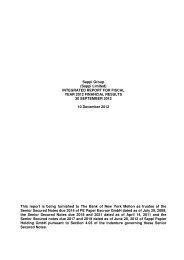2007 Annual Report - Sappi
2007 Annual Report - Sappi
2007 Annual Report - Sappi
You also want an ePaper? Increase the reach of your titles
YUMPU automatically turns print PDFs into web optimized ePapers that Google loves.
into account, unadjusted current market prices, estimated<br />
projected growth over the rotation period for the existing<br />
immature timber volumes in metric ton, cost of delivery and<br />
estimated maintenance costs up to the timber becoming<br />
usable. The discount rate used is the applicable pre-tax<br />
weighted average cost of capital of the business unit.<br />
Determining the appropriate discount rate requires significant<br />
assumption and judgement and changes in these assumptions<br />
could change the outcomes of the plantation valuations. The<br />
standing value of mature timber is based on unadjusted current<br />
market prices and estimated timber volumes in metric ton less<br />
cost of delivery.<br />
The age threshold used for quantifying immature timber is<br />
dependent on the rotation period of the specific timber genus.<br />
In the Southern African region, softwood less than eight years<br />
and hardwood less than five years is classified as immature<br />
timber. Management focuses their attention to good husbandry<br />
techniques, which include ensuring that the rotation of<br />
plantations is met with adequate planting activities for future<br />
harvesting. The rotation periods vary from eight to eighteen<br />
years in Southern Africa.<br />
Assumptions and estimates are used in the recording of<br />
plantation volumes, maintenance cost per metric tonne, and<br />
depletion. Changes in the assumptions or estimates used in<br />
these calculations may affect the group’s results, in particular,<br />
our plantation valuation and depletion costs.<br />
A key assumption and estimation is the projected growth<br />
estimation over a period of eight to eighteen years per rotation.<br />
The inputs to our immature timber growth model are complex<br />
and involve estimations and judgements, all of which are<br />
regularly updated. <strong>Sappi</strong> established a long term sample plot<br />
network which is representative of the species and sites on<br />
which we grow trees and the measured data from these<br />
permanent sample plots are used as input into our growth<br />
estimation. Periodic adjustments are made to existing models<br />
for new genetic material.<br />
<strong>Sappi</strong> manages the establishment, maintenance and harvesting<br />
of its plantations on a compartmentalised basis. These comprise<br />
pulpwood and saw logs and are managed in such a way so as<br />
to ensure that the optimum fibre balance is supplied to its paper<br />
and pulping operations in Southern Africa. <strong>Sappi</strong> owns<br />
approximately 369,000 (2006: 372,000) hectares of plantation<br />
and directly and indirectly manages a further 184,000 (2006:<br />
173,000) hectares established on land held by independent<br />
commercial farmers. <strong>Sappi</strong> provides technical advice on the<br />
growing and tendering of trees which are recognised as<br />
silviculture costs in cost of sales. 409,000 (2006: 398,000)<br />
hectares of this land is forested with approximately 37,3 million<br />
(2006: 38,2 million) standing tons of timber. Given the extent of<br />
our plantations between 30% and 40% of these areas are<br />
measured in a three year cycle in order to confirm the accuracy<br />
of the recorded volume changes.<br />
As <strong>Sappi</strong> manages its plantations on a rotational basis and by<br />
implication, the respective increases by means of growth are, over<br />
the rotation period, negated by depletions for the group’s own<br />
production or sales. Estimated volume changes, on a rotational<br />
basis, amount to approximately six million tons per annum.<br />
Depletions include the fair value of timber felled, which is<br />
determined on the average method, plus amounts written off<br />
against standing timber to cover loss or damage caused by fire,<br />
disease and stunted growth. Depletions are accounted for on<br />
a cost per metric ton allocation method. Tons are calculated<br />
using the projected growth to rotation age and are extrapolated<br />
to current age on a straight line basis.<br />
Ruling unadjusted current market prices applied at the reporting<br />
date, as well as the assumptions that are used in determining<br />
the extent of biological transformation (“growth”) can have a<br />
significant effect on the valuation of the plantations, and as a<br />
result, the amount recorded in the income statement arising<br />
from fair value changes and growth. In addition, the discount<br />
rate applied in the valuation of immature timber has an impact<br />
as tabled below.<br />
US$ million <strong>2007</strong> 2006<br />
Fair value changes<br />
1% increase in market prices 17 14<br />
1% decrease in market prices (17) (14)<br />
Discount rate (for immature timber)<br />
1% increase in rate (4) (3)<br />
1% decrease in rate 4 4<br />
Volume assumption<br />
1% increase in estimate of volume 6 5<br />
1% decrease in estimate of volume (6) (5)<br />
Growth assumptions<br />
1% increase in rate of growth 2 1<br />
1% decrease in rate of growth (2) (1)<br />
The group is exposed to financial risks arising from climatic<br />
changes, disease and other natural risks such as fire, flooding<br />
and storms and human-induced losses arising from strikes, civil<br />
commotion and malicious damage. These risks are covered<br />
by an appropriate level of insurance as determined by<br />
sappi limited | 07 | annual report 89
















